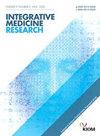Comparative effectiveness of traditional East Asian medicine treatments for temporomandibular joint disorders: A systematic review and network meta-analysis
IF 3
4区 医学
Q2 INTEGRATIVE & COMPLEMENTARY MEDICINE
引用次数: 0
Abstract
Background
Temporomandibular joint disorders (TMDs) cause pain and functional restrictions in the temporomandibular joint that interfere with daily activities. This study aimed to evaluate and compare the effectiveness and safety of various traditional East Asian medicine treatments, including acupuncture, electroacupuncture, moxibustion, and herbal medicine, in the management of TMD.
Methods
We included searches of MEDLINE, CENTRAL, EMBASE, AMED, CINAHL, OASIS, KISS, RISS, KMbase, KCI, CNKI, and CiNii from inception to November 12, 2023, for randomized controlled trials of traditional East Asian medicine treatments in patients with TMD. A network meta-analysis was performed using frequentist methods, and the Confidence In Network Meta-Analysis methodology were employed to assess evidence quality.
Results
Forty-five studies with 2,211 participants were finally included. Acupotomy (Mean difference (MD) -5.07, 95 % Confidence interval (CI) -7.37 to -2.78) and acupuncture (MD -1.18, 95 % CI -2.28 to -0.09) showed statistically significant superiority in reducing pain intensity compared to sham treatment. According to the SUCRA rankings, acupotomy was considered the most effective treatment, followed by electroacupuncture, acupuncture, manipulation, laser therapy and occlusal splint. A total of 12 studies reported incidence of adverse events, and none were serious adverse events.
Conclusion
Acupotomy and acupuncture could be more beneficial than sham treatment in pain relief and might be a better option than occlusal splint. However, future rigorous, well-designed trials are needed to draw clear conclusions.
Protocol registration
PROSPERO (CRD42023467340).
东亚传统医学治疗颞下颌关节疾病的比较疗效:系统综述和网络荟萃分析
背景:颞下颌关节疾病(TMDs)引起颞下颌关节疼痛和功能限制,干扰日常活动。本研究旨在评估和比较各种东亚传统医学治疗方法,包括针灸、电针、艾灸和草药治疗TMD的有效性和安全性。方法纳入MEDLINE、CENTRAL、EMBASE、AMED、CINAHL、OASIS、KISS、RISS、KMbase、KCI、CNKI和CiNii自成立至2023年11月12日的随机对照试验,检索传统东亚药物治疗TMD患者的临床试验。使用频率分析方法进行网络元分析,并使用网络元分析的信心方法来评估证据质量。结果共纳入45项研究,2211名受试者。针刀(平均差值(MD) -5.07, 95%可信区间(CI) -7.37 ~ -2.78)和针灸(MD -1.18, 95% CI -2.28 ~ -0.09)在减轻疼痛强度方面与假手术相比具有统计学上的显著优势。根据SUCRA排名,针刀被认为是最有效的治疗方法,其次是电针、针灸、手法、激光治疗和咬合夹板。共有12项研究报告了不良事件的发生率,没有严重的不良事件。结论针刀和针刺在缓解疼痛方面比假手术更有效,可能比咬合夹板更好。然而,要得出明确的结论,还需要未来严谨、设计良好的试验。协议注册prospero (CRD42023467340)。
本文章由计算机程序翻译,如有差异,请以英文原文为准。
求助全文
约1分钟内获得全文
求助全文
来源期刊

Integrative Medicine Research
Medicine-Complementary and Alternative Medicine
CiteScore
6.50
自引率
2.90%
发文量
65
审稿时长
12 weeks
期刊介绍:
Integrative Medicine Research (IMR) is a quarterly, peer-reviewed journal focused on scientific research for integrative medicine including traditional medicine (emphasis on acupuncture and herbal medicine), complementary and alternative medicine, and systems medicine. The journal includes papers on basic research, clinical research, methodology, theory, computational analysis and modelling, topical reviews, medical history, education and policy based on physiology, pathology, diagnosis and the systems approach in the field of integrative medicine.
 求助内容:
求助内容: 应助结果提醒方式:
应助结果提醒方式:


